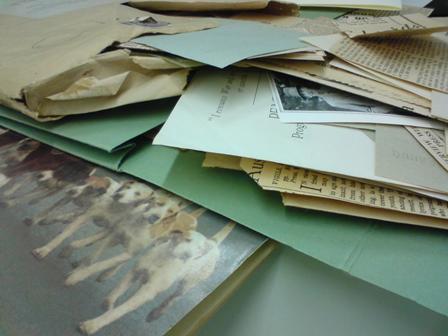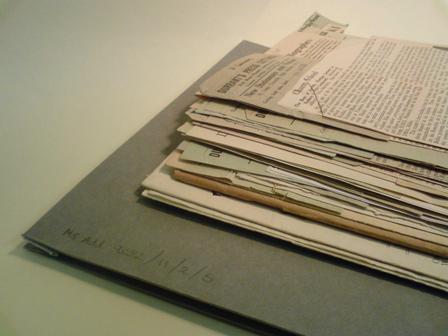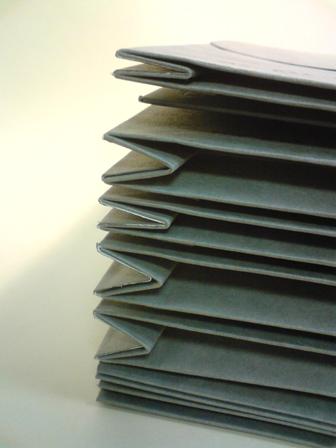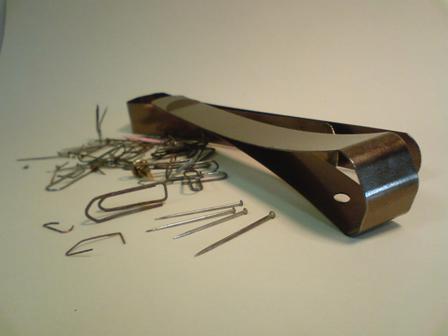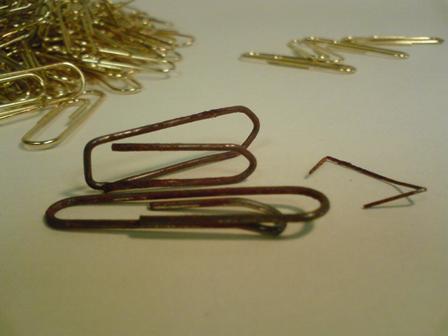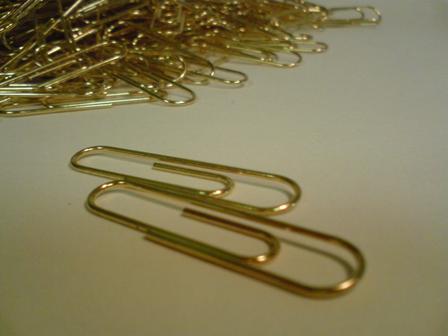With much of the ground work now done I am beginning to write detailed descriptions of the collection. There is a quantity of correspondence in which I am expecting to find the identification of authors by their scrawled signatures somewhat trying. Since we hold a number of other collections containing correpondence to Sassoon here at the Cambridge University Library I decided to improve my chances of deciphering some of the signatures by converting an existing catalogue to one such collection into a format that I could add to our cataloguing database. I am pleased to announce that this work is now complete and I have loaded the resulting descriptions onto the Janus website where you are welcome to browse through them along with other catalogues to archives held throughout Cambridge:
Link to the catalogue of MS Add.8889 on the Janus website
The content of the letters is rather varied as they are drawn from a variety of sources including items which Sassoon either placed or left enclosed in the volumes of his personal library. My particular favourite is a letter from Lady Ottoline Morrell ”enquiring the time of his arrival and asking him to bring a horse” (MS Add.8889/2/5).
Anyone with a Cambridge University Library reader’s card validated for the Manuscripts Reading Room may consult the letters. Information on how to apply for reader status is online on the Library’s Admissions pages.
One of the disadvantages of reading for pleasure rather than for research is there is (in me at least) a tendency for the choice of books to be fairly discursive. Consequently, when something interesting crops up it’s often difficult to spot that it might one day prove useful in another context and ought to be carefully noted down for future reference. And after a while, of course, I can no longer remember where on earth I read it.
During the time I’ve been working on Sassoon I’ve been trying to recall where I once saw (or heard – maybe it was on television or radio) the story of an old Army officer from the Great War who had been reading an anthology of the war poets. He had fought on the Western Front and spent a lot of time in the trenches. He wasn’t a literary man. He was asked what he thought of the poems of Sassoon, Owen and their contemporaries, and replied that yes, they were jolly good, very descriptive and realistic. Then he paused and added: ‘But those poet chaps – they do seem to have made rather heavy weather of it all!’
I’d very much like to pin this down. Can anyone point me to a reliable source for it?
A ‘guest post’ by Hannah Haines of the Library’s Entrance Hall staff.
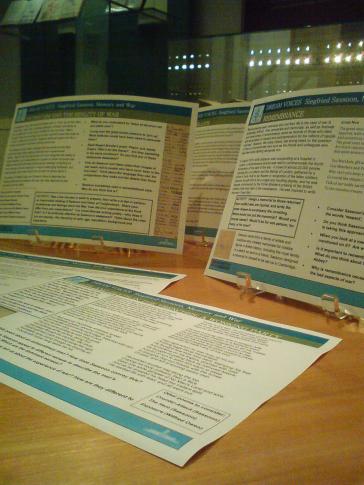
The 'Dream Voices' teaching resource in the Exhibition Centre
The history and literature of the Great War has been a topic on the GCSE syllabus for many years, and from the outset of planning the ‘Dream Voices’ exhibition, we were aware of the potential for involving local schools in the Sassoon project. Making the subject of conflict accessible to the 13–16 age group presents challenges, but by inviting pupils to engage with original historical sources, we hope to show how archival research can inspire lively insights into material they may have only seen printed in textbooks.
In order to maximise the appeal of an exhibition visit to teachers, we have put together a resource pack that highlights particular items from the collection and suggests discussion points to tie the visit to the curriculum requirements. We identified key themes that would be relevant to studies in English Literature, History and Citizenship, such as depictions of trench warfare, Sassoon’s anti-War protest of 1917, and the concepts of patriotism and remembrance. Although the process of writing the pack began before the exhibition was assembled, some of Sassoon’s best-known works presented themselves as suitable source material. There was an amount of adjustment to be done once the CD of exhibition images arrived (my first, excited, viewing of the archive!) – for instance, Sassoon’s sketch of a memorial statue to be erected in Cambridge adds a great visual element to discussions of how people can be encouraged to remember and commemorate war.
These packs have been dispatched to a number of teachers, and we hope that the result will be a number of small group visits in the Michaelmas Term that will take in the exhibition and suggested follow-up activities.
A recording of the Sassoon panel discussion in Cambridge on 20 July, with Jon Stallworthy, Max Egremont, Santanu Das and Tim Kendall, has now been made available via the University’s Streaming Media Service: <http://sms.cam.ac.uk/media/866563>.
The BBC news website has an audio slideshow based on ‘Dream Voices’, produced by Paul Kerley, who’s put together an interesting mixture of images, music and poetry. It’s at http://www.bbc.co.uk/news/uk-10714688.
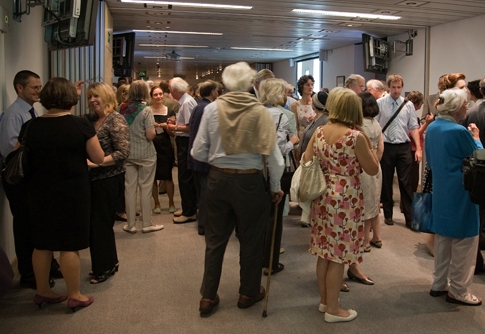
The 'Dream Voices' opening reception
The Library’s exhibition, ‘Dream Voices: Siegfried Sassoon, Memory and War’, opened to the public at 9.00 this morning. The supporting web pages are now visible at http://www.lib.cam.ac.uk/exhibitions/Sassoon/index.html.
Our celebration opening event yesterday afternoon went off well. About a hundred people attended a panel discussion in Robinson College, chaired by Jon Stallworthy. Max Egremont spoke on Sassoon’s life and continuing significance as a writer, Santanu Das explored Sassoon’s responses in verse and prose to the death of his friend David Thomas in 1916, and Tim Kendall spoke about ‘The Kiss’, the poem inspired by Major Campbell’s belligerent lecture on ‘The Spirit of the Bayonet’ (Sassoon’s notes taken at the lecture are on display in the exhibition). We’re planning to put a link to a recording of this event on the blog shortly.
Then it was back to the Exhibition Centre for the opening reception itself. Alison Richard, the University’s Vice-Chancellor, spoke about the importance Cambridge attached to securing the Sassoon Archive, and of the strong sense we had formed during last year’s fundraising campaign that there was a widespread appreciation in the country of the importance of Sassoon both as a writer and as a representative of the First World War generation. Max Egremont thanked the contributors to the fundraising effort, and underlined the general feeling that the Archive had found its proper home in the University Library, before declaring ‘Dream Voices’ officially open. We hope that as many people as possible will come and visit over the next five months.
No, not a verdict on the exhibition — but a vital piece of information missing from the ‘Motorbikes’ post below. I’ve been told by a conservator colleague who knows about these things that I should have specified the make of machine on which Ivan Hart-Davies made his record-breaking John o’ Groats to Land’s End ride. It was a Triumph.
The cleaning fluid used to give the glass of the Exhibition Centre display cases a last polish has a very distinctive smell – maybe it’s a detergent marketing team’s idea of ‘Pine’. Whatever it’s supposed to remind me of, I always find it evocative: it tells me the job of mounting the exhibition is more or less complete.
The fortnights during which we change our displays bring together the work of many of the colleagues who contribute to the exhibitions programme. The conservators, who have appraised every item to make sure it can be safely exhibited and spent weeks making cradles and backing-boards, now oversee the placement of the manuscripts, books and pictures in the cases. Once everything is in position we make final decisions on the shape of the caption labels, and the conservators print them onto heavy paper, cut them to size and back them onto board for a professional finish.
While this is going on, Imaging Services mount the wall panels. The panels – a metre by a metre and a half – describe the themes of the display and provide additional visual interest in the form of images of poems, drawings or diary entries that aren’t on show in the display cases themselves. The panels are printed here in the Library, but designed by an external design consultancy which has also worked on various other aspects of the ‘Dream Voices’ project, such as posters, banners and guides. There are four panels surrounding the pillar in the Exhibition Centre, and the Library’s joiners have fixed up a new system of frames for mounting these, which look very smart.
Our I.T. experts have prepared a full set of web pages to complement the exhibition, and these will go live at http://www.lib.cam.ac.uk/exhibitions/Sassoon/index.html later today. Meanwhile, my colleague as Joint Exhibitions Officer has been busy working on the distribution of print publicity and the production of large-type texts of the exhibition.
At the end of last week, just on schedule, we made the final adjustments to the position of the exhibits and captions: tiny nudgings and touchings, eighths and sixteenths of inches, until everything looks as straight and perpendicular as the uneven edges of elderly volumes and documents will allow. It’s only when exhibits and captions are brought together in the cases that we can see where shadows will fall, and we improvise with stands and mounts to avoid having shady patches in the wrong places. Yesterday morning the electrician refocused the spotlights on the wall panels, and the conservators have taken measurements of the light levels in the cases to ensure against damage to the paper, inks and pigments of the documents. The case lids have been closed for the last time, putting an air-tight seal between the exhibits and the outside environment. It’s now safe to squirt the cleaning fluid.
The smell of success? Our visitors will be the judges of that.
Blog readers with a subscription to the Times newspaper online site might like to read a recent article by Jack Malvern on the possible link between a sketch by Sassoon in one of his war journals and the poem Died of Wounds:
http://www.thetimes.co.uk/tto/arts/books/article2646164.ece
The journal to which the article refers (classmark MS Add. 9852/1/7) covers a period in mid 1916 when Sassoon was recovering from enteritis or ‘trench fever ‘. It is among the items that will be on show as part of the ‘Dream Voices’ exhibition which opens this Wednesday, and will be displayed showing his observations of events on 1 July 1916, the first day of the Battle of the Somme.
http://www.lib.cam.ac.uk/exhibitions/Sassoon/index.html


